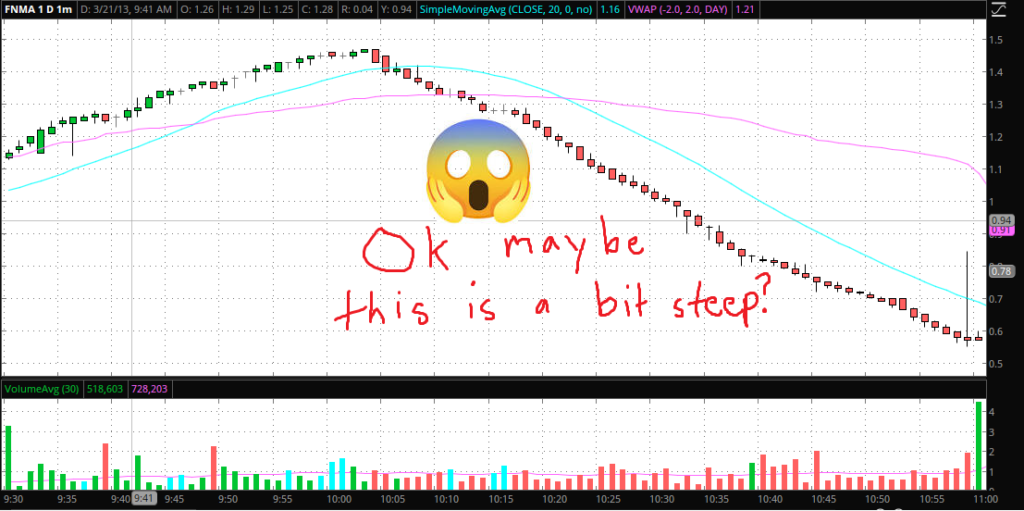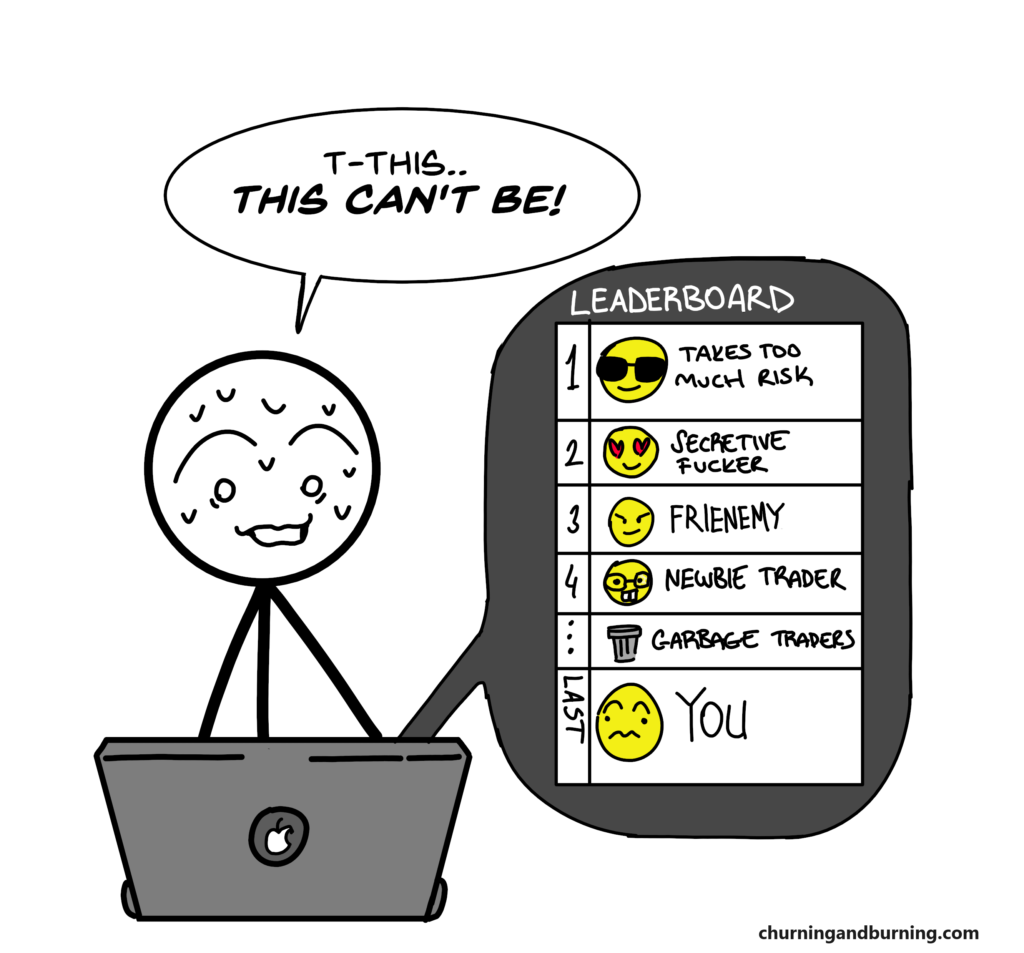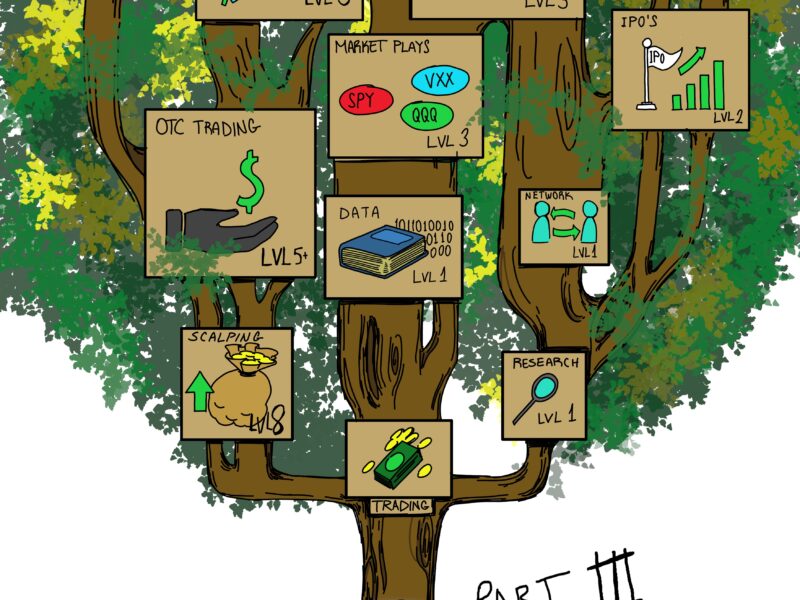I can’t believe what I’m seeing. It looked like it would be a normal correction at first but now it’s just selling off like it’s going to zero. This wasn’t some no-name penny play driven by stock promotion, it was Fannie Mae! An actual important company with real-world relevance and a market cap close to 1 billion dollars.1It makes me feel old to type this out but here’s the story: Fannie Mae and Freddie Mac had toxic asset issues during the 2008 Great Financial Crisis. Because they were too important to fail, the government took them into conservatorship rather than let them go bankrupt. That meant the government would retain all earnings, which left the equity theoretically worthless. The only value was the speculative proposition of FNMA leaving conservatorship status to be a public company again. Surely it has to bounce.

I channeled all my energy and went into hyperfocus mode for this bounce. I did a little mental rehearsal too: Ok I can do this. I have to step up. Just load up on that exact moment you see the volume surge on the bid, it’s the same pattern every time. I’ve seen many OTC bounces and how they unfold–how they just spring into 12 green candles in a row after capitulation. The .56 offer lifted and it’s a clean move up to .97. I sell into strength and I’m up about $6000 realized.

I don’t make a big show about it, I just tell a few friends. This trade came out of nowhere and I really needed it. My confidence that month had been rock bottom but now OTC Bandit Pete has come to the rescue while trading his retail account. It’s the first day at the new firm and this milestone win helps me reset the mood.
Victor somehow gets word of the trade. He’s chewing his gum, all casual… So Pete I heard you did good on Fannie Mae today. He starts to ask a series of questions. He asks me what broker I’m at and what routes I’m using and what I saw to make the trade. I explained that the FNMA bounce starts with a held bid that steps in at the very bottom and then climbs up in a controlled manner, penny by penny. It was like trading those 2008 financials in slow motion. It’s easy. He nods… interesting. I can see the wheels turning in his head.
At Y5 Trading Group, we were restricted on what we could trade for regulatory reasons. The CBOE would only let us trade listed stocks and options. We couldn’t trade futures, forex, fixed income or OTC stocks. Under WTG’s hedge fund model, we could now trade just about anything. I wonder if Victor is thinking about whether he should get MBC access to trade OTC stocks. Would it be worth it?
(continued from Joint Venture)
Nah. It’s probably not worth it. It’s a nice small-ball retail strategy but not scalable enough for an entire prop firm. The FNMA ran up on a dumb, unconfirmed rumor and collapsed quickly. The story is likely over. It’s a nice little moment for me but probably just a one-off. I didn’t even look at it the next day. It’s time to re-focus on my trading at WTG and find consistent strategies on listed stocks.
Real Time Risk
Did I tell you about the best feature on Pr0Trade? It’s a real game changer.
Pr0Trade had a real-time link-up blotter feature where you could see anyone’s PnL and their live trading positions. All you needed to do was request and then be granted permission by whichever trader you want to see. Then after you link that up, you could setup your TIX windows to populate with other traders’ real-time executions.
The Blotter would look like this:

You could see anyone’s real-time trading book or you could sort by account PnL and create a mini-leaderboard.
The Tix Window would tell you exactly who would trade what and when. It looks like this:

Everything was right in front of you. All of us original MBC guys linked up blotters, including Tuco, Avery, and Victor. We would see in real time who could trade profitably and who couldn’t. There were some traders at the Austin branch who linked up with us like Riggs and even Mr. West himself.
Here’s another thing about how Riggs had characterized the culture of the WTG trading desk–they really pushed for competition amongst traders. He said it was not uncommon to see guys one-upping each other on position size, even if the only reason for doing so was petty rivalry or toxic machismo. Bob gets long 2000 shares of BABA. Timmy Jim sees this and immediately jumps into 4000 shares and digs at Bob’s ego: “Haha only 2000 shares Bob?” Bob says “Fuck off Timmy J, you slick little fuck. Watch this.” and then he smashes his buy key to get a whopping 8000 shares. You get the point, they encouraged this madness.
I wanted things to feel pure, the way I felt all alone when trading the bitcoin crash in April–just me and my thoughts on the market and none of the irrelevant noise. Well that all goes out the window now. The awareness of the whole world’s PnL was like a line of cocaine for the bad-feeling neurons in my amygdala. Anxiety. Anger. Insecurity. Envy. Depression. Every negative feeling I ever felt specifically from trading on a desk with other people now intensified by an order of 20x. Sorry, did I say that the real-time blotter was Pr0Trade’s best feature? It’s also the absolute worst.
7 Situations Where PNL is Bad for Your Health
Knowing what everyone else is doing creates all these mind games that are unique only to this social aspect of trading. A trader with zero outside channels would never have to deal with any of this. Here are some common and very fun situations:
1. The whole desk gets into a play with size and you have FOMO so you jump in too. Usually this never works out because the best plays don’t let everyone hop in to ride the bus. By this time in our careers, most of us surviving MBC Junior Traders had a deep distrust of positions that “too many traders” got into. But it was funny to see the new guys get caught by the groupthink. Some summer class newb would call out a held bid on JPM and only the other newbs would take it. All of us older traders know it’s bullshit but we let them feel like they’re accomplishing something. Once they all get stopped out for the 57th time, they’ll learn their lesson. It’s a rite of passage all of us had to go through.
2. You are trying to bid into a stock on dips, with methodically order placement based on well-thought out price levels. You want a perfect average price because you don’t want to take excessive risk or incur any ECN market-taker fees. Before price gets close to your order, some troglodyte markets into his entire position and sprays the next 5 levels on the book. Okay, whatever, you’ll stick to your levels, he’s being reckless and the stock can pullback further. The stock doesn’t pullback more. You only have a starter position. The play works perfectly and that cretinous Neanderthal has his full size and he’s openly hollering on every new high. It’s an affront to your entire process. It feels like the market is mocking you. You might’ve even made a nice gain but he made 10x more. It feels like a loss because comparison is the thief of joy.
3. You see other traders stop out for a small loss while you’re trying to give it a wider stop. At first you feel like a stalwart–I have real conviction and these piker don’t! Then you get stopped out on full risk and you’re thinking ugh, why didn’t I just bail quickly like everyone else? And just like that, you’re right back into the MBC tight-risk trap that Tuco warned us about for the last 14 months.
4. A good trader takes the opposite position from you. He’s long while you’re short. You start to second guess yourself. Does he know something? You start to feel trading becoming adversarial. Is he fucking with me? I hope his ass gets burned. Being stubborn as you are, you keep the position b/c fuck him, what he does he know? You cheerlead your stock when it goes your way, rather than remaining detached. Then the position starts to go his way and against you, and it now dawns on you that you really don’t know anything and that he is, in fact, better than you.
5. A whale trader takes a huge position in the same trade you’re in. This happened once when some of us were shorting a low float stock called LIVE and Mr. West jumped into it with a ridiculously large position. The owner of the firm who routinely has 7-figure monthly swings got into one of my low float short plays. Confidence inspiring right? Maybe… LIVE averaged 1 mil volume/day and often traded with a point-wide spread. It had a nice red day at $30 where we all thought…Awesome! Maybe Mr. West helped suppress the price for us! Nope, it never works that way. It squeezed higher 2 days later and we got killed in slippage when Mr. West slammed out of his entire position for a loss and ran all our stops. Rough.

6. There’s a local trainwreck happening. Someone is destroying their account and your attention is diverted towards WTF they’re doing. Here’s a weird thing we started noticing about MBC partner and trading guru Avery. Every day, he’d trade a portfolio of 5 leading tech names and consistently profit in the $500-1000 range. It always bothered me how smug he’d sound when posting on Twitter and how the stocktwits circle ate it all up and worshipped him while all of us on the desk never got to see any of his supposed brilliance in real time. He was always the first to offer unhelpful and cherry picked criticism on our underperforming days–why didn’t you buy this level from the morning meeting? Why did you guys not hold longer to make more money? Tuco in particular hated it and called it Avery’s “time machine trading”.
Avery’s results, while much smaller than advertised, seemed okay… until earnings season came around. When the major tech names would announce, out of the blue my TIX Window would blow up with executions from Avery. All of a sudden, he’s trading 10x his usual size trying to fade an announcement spike. While normally a hands-off trader, when the chips are down Avery will go nuts by trying to scalp every micro-dip in an effort to repair his terrible average price. One of the very first PDF’s in the training program, which I’m sure he had a ton of input in, was to not double down on losers. And there he was, hacking away on an earnings announcement and doubling down on his losers. It didn’t make any sense. He’d average one earnings-driven meltdown per quarter and give back a month’s worth of his gains.

7. Being red on a day where everyone is green and killing it. You must have screwed up something big. You must have the choked on the big opportunity that everyone else capitalized on. There’s nowhere to run, everyone can see you on the blotter. Victor ought to create a dunce cap for whoever’s negative on the good days, just so the interns and the support staff know what a total fucking fraud you are.

Sometimes you have a bad day and it’s a bad day. But when the rest of the desk crushes it and then they get the atta-boy’s, the high fives and backslaps, and the free beer and pizza–it’s like there’s a party and only the good traders are invited. You, you have to stew away in the shame of red numbers. It’s your own Scarlet Letter. The top traders are puffing their chest and saying things like oh I should’ve made 5x as much as I did, it was so obvious we would bounce 20 handles there and you aren’t even green. Look in the corner, the guy with 6 weeks experience had a five-figure day and now Victor is tweeting about how’s the next great MBC trader. All he did was close his eyes and buy the market dip, he doesn’t even know anything. Meanwhile you traded your crummy little bullshit play and the results rightfully reflect your true ability. Good job, idiot. It’s all in front of you, everything fully transparent, but you couldn’t click the right buttons. Look at the blotter again dude–literally everyone made money! There’s obviously something wrong with you.
Trading by yourself already has enough mental obstacles. You have to find a way to stay stable and mentally sound, no matter what everyone else is doing. One part of me wanted to play the game. Stop being such a little bitch. Just go out there and show them how it’s done. Let’s play the leaderboard game and just go out there and win it. If all the best WTG guys got bigger via open competition, who am I to not embrace it? I’m a competitor too.
Another part of me wanted to run and hide. I didn’t want a little puppet master pulling my string on every trade, whispering to me: get bigger on this trade, everyone else is doing it. It’s stupid and immature. How is knowing anyone else’s PnL going to help me? Trading is an individual and personal journey.

I probably should have pulled the plug for my own good but I didn’t want to seem like I wasn’t being a team player. I stayed on the network but I would let myself X-out the blotter and TIX if I felt it was too distracting.
There was no hiding from PnL anywhere. Maybe the idea behind this radical transparency was to show new traders what was possible. You had the “Yesterday’s Top-5 Most Profitable” column staring right at you whenever you logged into the WTG trader portal. You had the “Top Traders of the Month” e-mail sent from WTG’s Chief Operating Officer. It would always be the same guys, like Riggs or Hopeland or Heath Wilson–the latter two I haven’t met yet but I’m trying to add them to my blotter to learn their secrets. The Austin desk initially made far more than the NYC desk so they gave us our own category, “Top Traders of NYC branch”, in an attempt to give us some face. There was also a portal feature called Data Warehouse where you could query the PnL of every single trader in the firm for any given timeframe. How much did Riggs make in 2013? Easy to search, he made $1.1 million net.
Profit. Loss. Money. Green and red. Numbers on a screen going up and down. It started to feel like my whole life and my entire identity. I couldn’t help it even if a part of me knew it was the wrong thing to focus on. You read all these books about being process-driven and then the results will come later… but then when you’re actually trading in real time, it all goes out the window and only the results matter. Being on the leaderboard was validation and validation was dopamine. Being down on the day and seeing everyone make money would make for depression fuel. I hated it and hated myself for getting so wrapped up in it. It wasn’t something I wanted to admit to anyone. There’s so much bravado on a trading desk; getting sucked into obsession over PnL and size becomes the norm. I thought I was alone in feeling so inadequate until one intense conversation with a friend, who I won’t name, while trading a breakout play on TSLA.
2013 was the ground zero of when TSLA suddenly became the hottest tech stock in the market 2and would remain so for the next decade. Their spring earnings quarter gave them the juice to trade to all time highs. My friend and I both exchanged notes on TSLA’s chart and we expected it to break $100 soon off the daily flag pattern. We both rated the setup an A+ conviction trade idea. We had the same initial entry, buying a pullback near the 5-min 20 period moving average early in the morning. He chose to get aggressive by adding into strength and then tightening his stop, while I still gave my stop to the early pullback lows. I think he 5X’d his size over $95.

He got low ticked right before the leg to new highs. I peeked over to see my friend’s face buried in his hands. I never do this but I very strongly suggested he re-enter TSLA. He was having a tough time and I badly wanted him to stay afloat. Below is our chat conversation, edited only for neatness.

Couldn’t have said it better myself. We’re all sick fucks. You have to be to do this.
(to be continued in The 10 Traders You’ll Meet in Prop)




Having the PnL there is a nice feature to encourage competition…. kinda reminds me of the VTF at “Y5,” even though PnL wasn’t included in the platform. I would see this as a major distraction and probably wouldn’t have it up.
I really love this series. Thank you! The part about Avery was very interesting. I find him insufferable on Twitter/X. :))